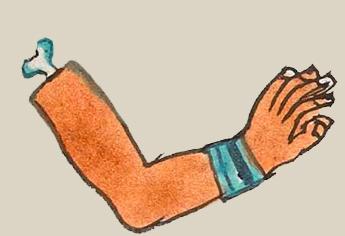maitl (Mdz38r)
This element that shows a hand or arm (maitl) has been carved from the compound sign for the place name, Coliman. The arm is cut off at the shoulder and a white bone protrudes at that site. (Some small amount of turquoise paint on the bone is a remnant of the water that we carved away when separating this element from the compound hieroglyph--see below, right.) This is a left hand and arm, colored terracotta, with the exception of the fingernails, which are white. The wrist has a turquoise blue bracelet or band. The band has black lines of different thicknesses that are somewhat reminiscent of water currents.
Stephanie Wood
The water that emerges from the site of the shoulder in the original compound calls to mind acolli (which would cover both the water "a" and the shoulder, "acolli"). The place names starts "Coli-," so the acolli may be there visually as a phonetic clue to the start of the place name. The "ma(n)" ending to the place name can be supplied by the hand/arm. According to Gordon Whittaker, we should pay attention to the upright hand without an arm attached versus the more horizontal or diagonal arm, which can have readings other than maitl, such as the ma of capture, ana of grab, or poloa of destroy (see: Deciphering Aztec Hieroglyphs, 2021, 104).
Stephanie Wood
Stephanie Wood
c. 1541, but by 1553 at the latest
Stephanie Wood
hands, arms, hueso, huesos

mai(tl), hand or arm, and a measurement, https://nahuatl.wired-humanities.org/content/maitl
ma(tl), hand or arm, and a measurement, https://nahuatl.wired-humanities.org/content/matl
hand or arm
Stephanie Wood
Codex Mendoza, folio 38 recto, https://digital.bodleian.ox.ac.uk/objects/2fea788e-2aa2-4f08-b6d9-648c00..., image 86 of 188.
The Bodleian Libraries, University of Oxford, hold the original manuscript, the MS. Arch. Selden. A. 1. This image is published here under the UK Creative Commons, “Attribution-NonCommercial-ShareAlike 3.0 License” (CC-BY-NC-SA 3.0).

